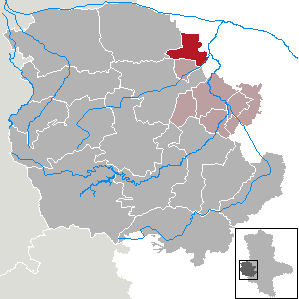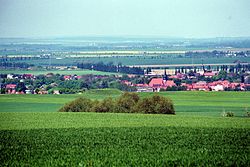The House of Ascania was a dynasty of German rulers. It is also known as the House of Anhalt, which refers to its longest-held possession, Anhalt.

Saxony-Anhalt is a state of Germany, bordering the states of Brandenburg, Saxony, Thuringia and Lower Saxony. It covers an area of 20,447.7 square kilometres (7,894.9 sq mi) and has a population of 2.19 million inhabitants, making it the 8th-largest state in Germany by area and the 11th-largest by population. Its capital is Magdeburg and its largest city is Halle (Saale).

Ballenstedt is a town in the Harz district, in the German state of Saxony-Anhalt.

Harzgerode is a town in the district of Harz in Saxony-Anhalt, Germany.

Schwanebeck is a small town in the district of Harz, in Saxony-Anhalt, Germany. It is part of the Verbandsgemeinde Vorharz.

Wegeleben is a town in the Harz district, in Saxony-Anhalt, Germany. It is the administrative seat of the Verbandsgemeinde Vorharz.

Osterwieck is a historic town in the Harz district, in the German state of Saxony-Anhalt.

The Principality of Anhalt was a State of the Holy Roman Empire, located in Central Germany, in what is today part of the federal state of Saxony-Anhalt.
Salzland is a district in the middle of Saxony-Anhalt, Germany. It is bounded by the districts Harz, Börde, Magdeburg, Jerichower Land, Anhalt-Bitterfeld, Mansfeld-Südharz and Saalekreis.
Harz is a district in Saxony-Anhalt, Germany.

Bernhard, a member of the House of Ascania, was Count of Anhalt and Ballenstedt, and Lord of Bernburg through his paternal inheritance. From 1180 he was also Duke of Saxony.

Henry I, a member of the House of Ascania, was Count of Anhalt from 1212 and the first ruling Anhalt prince from 1218 until his death.

Oberharz am Brocken is a town in the Harz District, in Saxony-Anhalt, Germany. It was formed on 1 January 2010 by the merger of the town of Elbingerode with the municipalities of the former Verwaltungsgemeinschaft Brocken-Hochharz.

Anhalt Castle is a ruined medieval fortification near the town of Harzgerode in Saxony-Anhalt, Germany.

Falkenstein Castle, also formerly called New Falkenstein Castle to distinguish it from Old Falkenstein Castle, is a German hill castle in the Harz Mittelgebirge, dating to the High Middle Ages. It is located in the town of Falkenstein between Aschersleben and Harzgerode.

The Selke is a river of Saxony-Anhalt, Germany.

The Konradsburg is a former castle, monastery and manor house near Ermsleben in the German federal state of Saxony-Anhalt.
Egeno II of Konradsburg was a free knight of Konradsburg, in the northeast of the Harz region in Central Germany, near Ermsleben.

Pansfelde is a village in the town of Falkenstein/Harz in the district of Harz in Saxony-Anhalt, Germany.




















